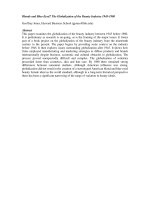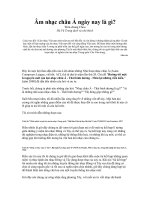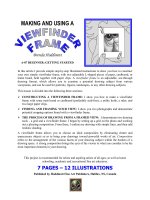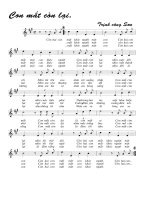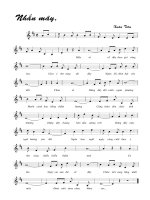Tài liệu In Rare Form A Pictorial History of Baseball Evangelist Billy Sunday pptx
Bạn đang xem bản rút gọn của tài liệu. Xem và tải ngay bản đầy đủ của tài liệu tại đây (3.37 MB, 169 trang )
B A S E B A L L E VANGELIST BILLY S U N D A Y
a pictorial histor y of
in rare form
.
. . i r s t e n b e r g e r
In Rare Form
000 fm (i-xiv) 7/7/05 9:01 AM Page i
000 fm (i-xiv) 7/7/05 9:01 AM Page ii
In Rare Form
A Pictorial History
of Baseball Evangelist
Billy Sunday
W. A. Firstenberger
university of iowa press Iowa City
000 fm (i-xiv) 7/7/05 9:01 AM Page iii
University of Iowa Press, Iowa City 52242
/>Copyright © 2005 by the University of Iowa Press
All rights reserved
Printed in the United States of America
Design by Richard Hendel
No part of this book may be reproduced or used
in any form or by any means without permission in
writing from the publisher. All reasonable steps have
been taken to contact copyright holders of material
used in this book. The publisher would be pleased
to make suitable arrangements with any whom it
has not been possible to reach.
Cover and title page image: Billy Sunday posing in
his basement at home in Winona Lake, Indiana.
Courtesy Chicago Historical Society, DN-006 9917.
Printed on acid-free paper
Library of Congress
Cataloging-in-Publication Data
Firstenberger, W. A. (William Andrew), 1966–.
In rare form: a pictorial history of baseball evangelist
Billy Sunday / by W. A. Firstenberger.
p. cm.
Includes bibliographical references and index.
isbn 0-87745-959-2 (pbk.)
1. Sunday, Billy, 1862–1935. 2. Evangelists—United
States—Biography. 3. Sunday, Billy, 1862–1935—
Homes and haunts. I. Title.
bv3785.s8f57 2005
269'.2'092—dc22 2005043914
{b}
05 06 07 08 09
P
54321
000 fm (i-xiv) 7/7/05 9:01 AM Page iv
Contents
Preface and Acknowledgments vii
Introduction xi
1 Homespun and Cashmere 1
2Caught on the Fly 11
3 Revival Machine 24
4For the Love of a Nation 55
5At Home in Winona Lake 76
Epilogue 104
Appendix A. Revivals and Appearances 111
Appendix B. Conversions 120
Appendix C. Evangelistic Team Members 124
Appendix D. Family Genealogy 127
Notes 139
Bibliography 143
Index 149
000 fm (i-xiv) 7/7/05 9:01 AM Page v
000 fm (i-xiv) 7/7/05 9:01 AM Page vi
The photograph facing this page is an extraordinary image. Billy
Sunday is poised to deliver a dramatic blow to the chin of Satan. Sunday
used this pose and other active postures regularly in his promotional
materials and sermons to illustrate the spiritual combat all individuals
fight against sin. Rare among early prints, this photograph is date
stamped. Taken as a publicity photograph in March 1918 by the Chicago
Daily News, this image of Sunday would have been displayed in the
newspaper as a cutout figure without any background during his
Chicago revival. For our purposes, however, the backdrop remains as
salient as his figure, for he is standing in the basement of the family
home in Winona Lake, Indiana, in front of a mass of personal posses-
sions. In the foreground we see the public persona of Billy Sunday, but
in the background we see his “stuff,” the material objects of his past,
which, to this date, have still not told their side of the story.
Artifacts and images can only tell a story, however, if they are pre-
served. For this reason alone, this book is dedicated to the memory of
Helen A. Sunday, Billy Sunday’s wife, whose singular act in her last will
and testament to preserve the Sunday home made possible not only this
study but also opened the doors of experiencing the Sunday family story
for untold future generations. She made this unselfish gift because
thousands of Bible conference attendees enjoyed her personal tour of
the family home during the last twenty years of her life; thus she saw the
value in keeping the collection intact (fig. 1). She was a woman ahead of
her time in numerous ways, and her life and influence upon Sunday are
a major focus of this book. To understand the motives of Billy Sunday,
one must first comprehend the depth of involvement that Helen Sunday,
better known as Nell, brought to the plate. She was his business man-
ager, spiritual counselor, loving mate, and one true friend. Without
Nell’s abilities or support, it is difficult to imagine Billy Sunday ascend-
ing to anything higher than a regionally successful preacher. With Nell
Preface and
Acknowledgments
000 fm (i-xiv) 7/7/05 9:01 AM Page vii
at his side, Billy transformed himself into America’s great “Baseball
Evangelist.”
No work such as this occurs without the assistance and guidance
from many individuals. The staff at the University of Iowa Press have
been of great assistance to me, as a first-time author. Press director
Holly Carver took me under her wing and guided me through difficult
decisions. Managing Editor Charlotte Wright tended to numerous
details, keeping the project on track. Freelance copyeditor Robert Burch-
field helped me hone my thoughts into clear statements. During my
graduate education at Indiana University, the thesis of which focused on
Billy Sunday and served as a germ of an idea for the approach of this
book, I was privileged to be under the counsel of Donald B. Marti as my
academic adviser, as well as a thesis committee consisting of Daniel V.
Olson, Patrick J. Furlong, and Lester C. Lamon. Their guidance and
strong encouragement to publish this work greatly bolstered my efforts.
The entire Winona Lake, Indiana, community has likewise been a
tremendous source of assistance. I am indebted to Brent Wilcoxson,
Preface and Acknowledgmentsviii
figure 1. Nell “Ma” Sunday, seen here in the Sundays’ dining room circa 1945,
was the first and best tour guide of the Sunday family home. Image courtesy of the
William and Helen Sunday Archives, Grace College, Winona Lake, Indiana.
000 fm (i-xiv) 7/7/05 9:01 AM Page viii
managing director of the Village at Winona, and Indiana State Museum
officials Dale Ogden and Rachel Perry for my appointment as consultant
curator to the Billy Sunday Historic Site Museum. These individuals
gave me the opportunity to develop this new museum, and without their
initial confidence in my ability and continued support over the years,
this work would not have been possible. The staff at Morgan Library of
Grace College, specifically Director of Library Services William Darr and
Associate Director for Public Services Rhoda Palmer, were invaluable to
my efforts, as they gave me access to and assistance with the William
and Helen Sunday Papers Collection. Steve Grill, director of the Reneker
Museum of Winona History, also deserves credit for imparting his
unique insights on Billy Sunday’s role within the Winona Lake commu-
nity and opening to me the collections under his care for research.
Reneker Museum volunteer Gerald Polman was of particular assistance
in helping me document Sunday’s appearances and meetings in
Winona Lake. Al Disbro kindly volunteered his expertise in photograph-
ing the artifacts that illustrate this book. Numerous Winona Lake resi-
dents were interviewed, and many of their recollections have found their
way into these pages. Perhaps most of all, I wish to thank the more than
fifty members of the Billy Sunday Historic Site Museum volunteer corps
for their unyielding support in making the Sunday home an invaluable
experience for visitors.
I wish to further express my gratitude to the many thousands of visi-
tors who have come to the Billy Sunday Historic Site Museum since it
opened full-time to the public in May 2000. Much of the material in the
appendixes was included in direct response to visitors’ requests for spe-
cific statistical information about Billy Sunday’s revivals and family.
Joseph M. Sanford compiled a wonderful assemblage of postcard
images of Billy Sunday and his tabernacles, which he self-published in
June 2004. His work led to significant contributions in the appendix
addressing Sunday’s revivals and appearances. Sunday scholar Jim
Lutzweiler has taken on the thankless job of compiling local newspaper
accounts of Sunday’s revivals, and I discovered many new tidbits of
information by using his work as a resource. Longtime Sunday family
friend Phyllis P. Leedom of Anderson, Indiana; Billy Sunday Museum
volunteer Susan Hight; Rick Sonday of Whitby, Ontario; and Sunday rel-
atives Jim Woods of Huntington, Indiana, and Harry Ashley Sunday of
Hood River, Oregon, were of particular assistance in developing the
Sunday family genealogy included in the appendixes. Contemporary
Preface and Acknowledgments ix
000 fm (i-xiv) 7/7/05 9:01 AM Page ix
Sunday biographers Robert Martin, Wendy Knickerbocker, Lyle Dorsett,
Rachel Phillips, and Roger Bruns, along with Craig Bentley of the
Columbus Revival Heritage Museum, have all been most encouraging.
A very special thanks goes to my friend Brent Grosvenor, who presently
travels the country full-time with his wife and two daughters delivering
his well-researched, one-man Broadway-style musical Sunday in Man-
hattan, for keeping the Sunday name at the forefront of the American
consciousness. My gratitude goes out to Jane Powell Fesler, one of Billy
Sunday’s last converts in 1935, who granted me more than just an inter-
view but also an opportunity to see at firsthand how this man personally
touched the lives of others.
Lastly, I wish to acknowledge the support of my family and friends,
who collectively give me purpose and bearings. My Notre Dame broth-
ers, aka the Loons, share greater wisdom than their moniker suggests,
and several read drafts of this manuscript and offered indispensable
advice. My late father, Bill, started me as a youth down a path in pursuit
of truth, a worthy journey that mounts with age. My mother, Fran, has
given me more than life; she grounds my perspective in the real world,
which is fundamental to the material culture approach. My son, Eric,
gave up precious time with Daddy, but not so much time that it revealed
I had failed to learn the lessons from Sunday’s own family. Finally, this
book is for my wife, Lori, whose quiet beauty and grace keep me in a
state of eternal wonder and whose love completes the circle of my life.
Preface and Acknowledgmentsx
000 fm (i-xiv) 7/7/05 9:01 AM Page x
In Rare Form. The phrase seems well suited to Billy Sunday. It was,
and still is in certain circles, a colloquial phrase related both to athletes
and public speakers being at the top of their game, the peak of their level
of performance; therefore it applies directly to Sunday’s baseball career
and his expressive preaching style. The rarity of the images in this book
as well, most of which have never been made public prior to this publi-
cation, speaks to the exclusivity of this hidden treasure trove. Finally, and
perhaps most significant, this book has been faithfully produced with
attention to honoring the decorative details of the Arts and Crafts book-
publishing tradition. As such, this book is a revived manifestation of a
largely forgotten craft and in its own way is a contemporary artifact “in
rare form.”
Billy Sunday, America’s great “Baseball Evangelist,” has been the sub-
ject of numerous public reviews through the years in the form of popu-
lar magazine articles, editorial cartoons, authorized biographies, and
unsolicited scholarly biographies. Perhaps surprisingly, this interest in
Sunday has not faded over time, and he remains a popular figure for
today’s generation. The goal of this work is to provide a new perspective
on Billy Sunday by examining the photographic record of his life as well
as the landscape, structure, and contents of his home in Winona Lake,
Indiana, as if it were a pristine archaeological site. This aim is most
unusual for the field of material culture studies for three reasons. First,
this book will examine an individual whose thoughts and actions were
extensively documented from almost every conceivable angle by the sub-
ject himself, his admirers, his critics, contemporary historians, and
recent biographers well removed from the emotional halo surrounding
Sunday’s career. Second, instead of dealing with the tangible issues of a
typical archaeological investigation, such as subsistence patterns or
technological achievements, Billy Sunday dealt with social issues at the
deepest personal levels of human thought, such as the salvation of one’s
I
contend
there
should
be some
visible
connection
between
the thing
a man
believes
in and
himself.
—Billy
Sunday, in
twenty
years
with
billy
sunday
by Homer
Rodeheaver
Introduction
000 fm (i-xiv) 7/7/05 9:01 AM Page xi
soul. Finally, this book provides a very real departure from most material
culture analyses in that it is a biographical account of one individual
from the relatively recent past. The interpretations this book offers will
therefore be an intimate perspective on one man and one family and the
objects and images that reflect their deepest convictions. In many ways,
this book provides a litmus test for both the validity and the breadth of
material culture studies.
Having artifacts as the primary source of data, one might initially pro-
pose an analysis based upon artifact types similar to the manner in
which objects are cataloged (that is, furniture, food-processing equip-
ment, household maintenance supplies, and so forth). If the goal was to
discuss the organization of museum objects, such a strategy would be
entirely appropriate; in this instance, however, artifacts merely serve as
the conduit through which the historical figure of Billy Sunday is exam-
ined. Therefore, this study is organized according to subjects relevant to
Sunday’s life: childhood, baseball, evangelism, social issues, lifestyle,
and family relations. Each section uses a broad variety of artifacts and
images to substantiate interpretations. Also, within each chapter, the
consistency between the material evidence and traditional historical
interpretations of the same subject is examined.
One other point relates directly to the appropriateness of a material
culture analysis of Billy Sunday. Both scholars and the public at large
often view the two perspectives of material reality and spiritual reality as
incompatible foes. Yet Sunday, in his own words quoted at the beginning
of this introduction, admits the verity of an intersection between the
material and spiritual worlds. There exists a consensus of written docu-
mentation, both in Sunday’s own writings and in the first- and second-
hand accounts of those who knew and studied him, that he held a very
strong antimaterialist view of the world. His unyielding faith in an all-
mighty God whose imminent return to this world would result in the
final judgment of souls is an interpretation of Sunday’s psyche that this
study examines in some depth. Taking this spiritual creed as a given at
the onset of this examination, one cannot help but presume that Billy
Sunday would have had many misgivings about allowing this type of
analysis to be applied to his life. For this reason, a Billy Sunday quotation
has been inserted at the beginning of each section, providing him a
place at the table in this debate. The interpretations realized through this
approach gain credibility, however, from the irony that Sunday would
have likely dismissed this perspective. If Sunday did indeed devalue the
Introductionxii
000 fm (i-xiv) 7/7/05 9:01 AM Page xii
material possessions of life, then this character trait will certainly be
reflected in the items he did or did not possess. If his personal actions
betray this public conviction, that, too, will be revealed in the material
culture. Artifacts do not reveal everything that happened in the past, but
they very rarely lie about what they do tell us. Let us now see what they
have to say about Billy Sunday.
Introduction xiii
000 fm (i-xiv) 7/7/05 9:01 AM Page xiii
000 fm (i-xiv) 7/7/05 9:01 AM Page xiv
Few artifacts survive that deal either directly or indirectly with Billy
Sunday’s childhood. Such a paucity is most certainly predictable consid-
ering the impoverished setting in which he was raised. The written facts
surrounding his childhood tell of a long chain of broken familial bonds,
and the absence of material culture representing this part of his life may
be used to reinforce this traditional interpretation. Typically in an
archaeological setting, one relies on both the presence of unique arti-
facts with known dates as well as the absence of commonly found arti-
facts to assist in interpreting surrounding material that may not carry
precise information.
1
These techniques may be applied to historic collections, if it is rea-
sonable to assume that the collection, like an archaeological site, has
remained largely undisturbed. Indeed, while such an occurrence is very
rare, Mount Hood, the Billy and Helen Sunday home in Winona Lake,
Indiana, is just such a case. After moving their belongings from Chicago
to Winona Lake in 1911, the Sundays added to their possessions, but pre-
cious few items were removed. In her last will and testament, Helen
Sunday requested that the Mount Hood home remain intact as a shrine
to her husband’s memory, which perpetuated the integrity of this time
capsule. While a few changes in interior room colors or furniture layouts
were made over the last ninety years (all of which were easily reversible),
the artifact collection has remained intact. Accordingly, with the
integrity of this rare collection established, we may proceed with appro-
priate methods of interpretation.
Farm Boy William Ashley Sunday
When the Devil robs a boy, the last thing he takes from him is
what he learned at his mother’s knee.—Billy Sunday Speaks!
William Ashley Sunday was born on a farm in Story County, Iowa,
November 19, 1862, only thirty-three days before his father died of an
The web
of this
nation is
made from
the thread
spun in
the home.
–
billy
sunday
speaks!
Chapter 1
Homespun
and
Cashmere
010 c1 (1-10) 7/7/05 9:01 AM Page 1
undetermined illness while serving in Iowa’s Twenty-third Volunteer
Infantry Regiment of the Union Army.
2
Billy was sickly and too weak to
even sit up or walk on his own for nearly three years, until a traveling
doctor gave him a potion made from local roots, leaves, and berries that
brought about a complete physical turnaround. Tragedy became a way of
life for him during his childhood. In the first ten years of his life, Billy
experienced the death of his father, his half-sister’s death in a tragic bon-
fire accident, and the deaths of four aunts, an uncle, and his beloved
grandmother, all from tuberculosis. His oldest brother, Albert, was
kicked in the head by a mule and eventually had to be institutionalized.
3
This wave of hardship and death would leave a lasting mark on Billy that
helped to shape his later views on salvation and heaven.
Billy’s sorrows continued in 1874 at the age of twelve, when he and
his older brother Ed were sent to the Iowa Soldier’s Orphan Home.
4
Some mystery surrounds the sending of these two boys to the orphan-
age since Billy’s grandfather, Squire Martin Cory, lived near the family
and was financially able to support the small family. Yet he stood by and
allowed the two boys to be sent 130 miles away to the Glenwood orphan-
age. Recent scholarship has pieced together the most likely scenario that
led to this family hostility. A good deal of conflict apparently existed
between Martin Cory and his daughter, Mary Jane (Jennie), Billy’s
mother (fig. 2). Jennie’s second husband, James M. Heizer, had finan-
cially abused his position as guardian of the Sunday boys. He not only
confiscated their Civil War pension appropriations but also placed Cory
liable for the debt since Cory had agreed to serve as Heizer’s bondsman
when Heizer had become the children’s guardian. When Heizer aban-
doned the family in 1871, Cory was left holding the bag for the misap-
propriated pensions and other debts. The combination of monetary
strife and his frustration with his daughter’s choices in men probably
led to the unfortunate situation of the Sunday children being caught in
the middle.
5
The result of this family tension, coupled with Jennie Cory’s inability
to support her children, was the sending of her two youngest sons to an
orphanage for the offspring of fallen Union soldiers. While the separa-
tion from his mother was traumatic, it was probably the single biggest
turning point in young Billy’s life. Besides receiving superior schooling
in the basic skills of reading, writing, and arithmetic, he learned valu-
able social skills from living with countless other children. During those
long years away from home, he learned to defend himself, take pride in
Homespun and Cashmere2
010 c1 (1-10) 7/7/05 9:01 AM Page 2
figure 2. Mary Jane (Jennie) Cory Sunday Heizer Stowell, Billy’s mother,
standing in front of the log cabin in Story County, Iowa, where Billy Sunday was
born. This circa 1885 photograph is the only known image of Billy’s half brother,
who Jennie had with her last husband, George Stowell. Image courtesy of the
William and Helen Sunday Archives, Grace College, Winona Lake, Indiana.
010 c1 (1-10) 7/7/05 9:01 AM Page 3
his work, and discipline his behavior. While as a youth he did not com-
pletely internalize the message of the sermons he heard, the orphanage
regularly exposed the children to Bible lessons. Lastly, he developed his
physical prowess for speed. In particular, he learned the basics of the
game of baseball (spoken as two words: “base ball,” in his youth) and
how his sprinter’s quickness could make him a valued asset on almost
any team. These learned and developed skills served him immediately
when he returned to live on the farm in 1876 (fig. 3).
While the scarcity of childhood artifacts in Sunday’s possession
remains consistent with the written tradition that he was brought up in
an economically depressed household, the handful of surviving child-
hood-era artifacts do yield a few insights. Two medals and four badges
from the Civil War Survivors Association were found in the master bed-
room dresser (fig. 4). These items were given only to the widows and
children of fallen soldiers at Grand Army of the Republic encampments
and other similar veterans’ meetings. These six objects most certainly
Homespun and Cashmere4
figure 3.
Billy Sunday just as he
was beginning his baseball
career in 1884 at the age of
twenty- two. This is the
earliest known photograph
of Sunday. Image courtesy
of the William and Helen
Sunday Archives, Grace
College, Winona Lake,
Indiana.
010 c1 (1-10) 7/7/05 9:01 AM Page 4
belonged to Billy’s side of the family, since no one in Nell’s immediate
family is known to have perished in the war, although her father,
William Thompson, did serve in the Fifty-first Infantry Regiment of Illi-
nois. A child’s bugle-type horn from the time period of Billy’s youth
could well have been his and may also have been a reminder of his father
who died for the Union cause. These artifacts, which point toward a
period of sorrow and want in young Billy’s life, of course also reflect
national pride, the fight for moral values, and America’s claim to the title
of “God’s chosen country,” themes that would be carried through to his
evangelical career. These values are verified by his ownership of a bound
volume of the Roster and Record of Iowa Soldiers in the War of the Rebel-
lion. Billy did not own the entire set, only volume 3, which contained his
father’s listing, suggesting that this book was an object that he actively
sought to possess.
Homespun and Cashmere 5
figure 4. Clockwise from upper left: framed sampler of Cory family, Roster and
Record of Iowa Soldiers in the War of the Rebellion, salt print of Squire Martin
Cory, two Grand Army of the Republic survivor badges, nineteenth-century bugle horn.
Items courtesy of the Billy Sunday Historic Site Museum, Winona Lake, Indiana.
010 c1 (1-10) 7/7/05 9:01 AM Page 5
A cross-stitch sampler (fig. 4) with the names of his grandparents on
his mother’s side (Martin and Mary Cory), his grandfather’s second wife
(Charlotte Cory), his father and mother (William and Jennie “Sundy” —
the “a” left out due to lack of space), and his mother and her second hus-
band (Matt and Jennie Heizer) suggest that this item is from the brief
period of time in Billy’s life after his mother remarried but before 1874
when she was forced to send Billy and his brother to the orphanage. This
memento, probably created by his mother, atypically chronicles a suc-
cession of wives.
A salt-print photograph of Billy’s grandfather Squire Martin Cory was
also likely passed down to Billy from his mother. While Billy always pro-
fessed to hold his family in the highest regard, and indeed his mother
did live with Billy and Nell seasonally at Mount Hood before her death
in 1916, little material culture exists to reflect strong familial bonds. Nei-
ther handmade crafts from mother to son nor evidence of lavish gifts of
a successful preacher to his elderly mother are to be found in the collec-
tion. The scarcity of photos of his mother or his brothers reaffirms the
paucity of early family artifacts, suggesting erratic, fragmented relation-
ships with kin. This interpretation is entirely consistent with docu-
mented accounts of Billy’s ongoing frustrations in relationships with his
grandparents, stepfathers, and siblings.
For all the emphasis made in biographical accounts of Billy’s experi-
ences at the Iowa Soldier’s Orphanage, not a single artifact has been
uncovered in the Sunday home representing this time in his life. Writ-
ten accounts document that Billy’s brother Ed, as an adult, returned to
the orphanage to work there as a carpenter and watchman for many
years, further suggesting a continuation of the link between this institu-
tion and the Sundays.
6
During Sunday’s campaigns, much was made in
the newspaper coverage of this difficult hurdle in his life, and while he
apparently visited the Reynolds Presbyterian Orphanage in Albany,
Texas, in 1918, where the children gave him a bull’s horn presentation
trophy, the lack of any items representing the Iowa orphanage remains
a mystery. This absence of material remains does not necessarily sug-
gest that the written accounts are inaccurate. However, it is curious that
physical evidence of the Iowa Soldier’s Orphanage connection is so
weak, considering how much material culture in the home reflects other
institutions that reputedly had positive impacts on Billy’s life, such as
the Pacific Garden Mission, the Young Men’s Christian Association
(YMCA), or major league baseball.
Homespun and Cashmere6
010 c1 (1-10) 7/7/05 9:01 AM Page 6
City Girl Helen Amelia Thompson
Better die an old maid, sister, than marry the wrong man.
—The Real Billy Sunday (Brown)
Helen Amelia Thompson was born in Dundee, Illinois, on June 25,
1868, but the family soon moved to Chicago after her birth. Nell’s par-
ents, William and Ellen Thompson, were immigrants from the Scottish
highlands. A successful dairy businessman and staunch Presbyterian,
William Thompson was able to provide well for his family, giving Nell
many luxuries in her youth that would have been inconceivable to Billy
Sunday. She attended private schools and received lessons in music and
the arts. At the time she met Billy, both were involved in serious rela-
tionships bordering on official engagements of marriage: Billy with a
woman named Clara, whom he had been seeing for three years in Iowa
before beginning professional baseball, and Helen with a churchmate,
Archie Campbell.
7
Not at all impressed with the country bumpkin base-
ball player Billy Sunday, William Thompson strongly discouraged their
courtship, but to no avail. Billy eventually won over William Thompson
due in no small part to considerable backing from Nell’s mother. After
their marriage, which took place in the Thompson home, Billy and Nell
lived for twenty-two years in the brownstone at 64 Throop Street directly
adjacent to the site of their wedding (fig. 5).
Several of Nell Thompson’s artifacts support the interpretation that
this couple came from decidedly different backgrounds. A tintype of
herself with two teenage friends, a fancy velvet-covered autograph
album filled with good wishes from high school classmates, and several
early cabinet photos of herself and family members indicate that Nell
had a stable home life and a set of parents who could provide well for
their children (fig. 6). Included in the Sunday home’s collection are sev-
eral fine examples of Victorian-period Eastlake-style furniture that origi-
nally belonged to the Thompson family. Two three-piece sets of
Victorian furniture, both of which consist of two side chairs and a plat-
form rocker, all came from the Thompson household. The most elabo-
rate of these hand-me-downs is an Eastlake settee with decorative birds
of inlaid wood. Nell recalled in her memoirs how she and Billy did their
courting on this settee in her mother’s parlor in the 1880s.
8
Her school-
books, such as Gray’s School and Field Book of Botany and The Packard
Commercial Arithmetic, reveal that Nell received much more advanced
schooling than Billy. The latter text also foretold her invaluable role as
Homespun and Cashmere 7
010 c1 (1-10) 7/7/05 9:01 AM Page 7
future business manager of the grand revival campaigns. Also from this
period are Nell’s oil paintings, a collection of a dozen paintings of vari-
ous subjects. The original box of tube paints from this early time in her
life still survives in the family collection. Nell’s mother hired an itinerant
French artist to give her daughter lessons, and Nell painted a wide vari-
ety of subjects as exercises, including still lifes of fruit and floral arrange-
ments, a seascape, several rural landscapes, a western mountain
landscape, and her own interpretation of the well-known painting
Pharaoh’s Horses.
9
The rural landscapes are particularly revealing in that
they represent Nell’s vision of a lifestyle so different from her own yet
strikingly similar to Billy’s childhood experiences (fig. 6). One wonders
if Billy chuckled under his breath when he observed in Nell’s rural land-
scapes fat chickens, full bowls of ripe fruit, and well-tailored clothes,
when he often recalled that life on the hardscrabble farm included
hunger and homespun pants that “couldn’t tell whether I was coming or
going.”
10
Unlike Billy, Nell Thompson was a child born with a silver
Homespun and Cashmere8
figure 5. The Thompson family in front of their brownstone home at 62 Throop
Street, Chicago, circa 1885. Nell Thompson (Sunday) is shown sitting on the railing
in the center. Image courtesy of the William and Helen Sunday Archives, Grace
College, Winona Lake, Indiana.
010 c1 (1-10) 7/7/05 9:01 AM Page 8
spoon in her mouth. She even had two spoons from which to choose, a
set of two Towle Company silver-plated spoons bearing her monogram,
“H.A.T.”
The Sunday home yields an interesting assemblage of artifacts from
1886 to 1890, a period that includes Billy’s conversion to Christianity,
his courtship of Nell, and the first years of their marriage before he left
baseball. Nell’s copy of the Hymnal of the Presbyterian Church in Canada
provides an important link between this future husband and wife and
the Presbyterian denomination. She was very active in Chicago’s Jeffer-
son Park Presbyterian Church, where her parents were members. She
sang in the choir, vigorously participated in the Christian Endeavor Soci-
ety, and held the position of superintendent of the Intermediate Depart-
ment of Sunday Schools for the church.
11
Index to the Bible, given to Nell
by her aunt Sue in 1887, further suggests that she took a very serious,
Homespun and Cashmere 9
figure 6. Clockwise from the top: rural landscape oil painting by Nell
Thompson (Sunday), tintype of Nell with friends, box of tube paints, two H.A.T.
monogrammed silver spoons, The Packard Commercial Arithmetic. Items
courtesy of the Billy Sunday Historic Site Museum, Winona Lake, Indiana.
010 c1 (1-10) 7/7/05 9:01 AM Page 9
scholarly approach to her faith. By contrast, Billy was a newly formed
Christian, and although his mother was a staunch Methodist, Billy
openly admitted that his foundation in the Presbyterian denomination
was due to Nell. He stated on several occasions, “She was a Presbyterian,
so I am a Presbyterian. Had she been a Catholic, I would have been a
Catholic — because I was hot on the trail of Nell.”
12
But Billy did have
competition. Three books by Oliver Wendell Holmes, The Poet at the
Breakfast-Table, The Professor at the Breakfast-Table, and The Autocrat of
the Breakfast-Table, were Christmas gifts in 1886 from Nell’s longtime
steady boyfriend, Archie Campbell. Billy Sunday was nothing if not per-
sistent. He recalled in an autobiographical account that Nell wore an
expensive oxblood cashmere dress and lynx stole on New Year’s night
when he proposed marriage and that she looked “like the Queen of
Sheba did when she visited Solomon.”
13
A printed card announcement
of the Sunday-Thompson wedding on September 5, 1888, verifies that
Billy’s diligent pursuit of his quarry finally paid off.
Homespun and Cashmere10
010 c1 (1-10) 7/7/05 9:01 AM Page 10

